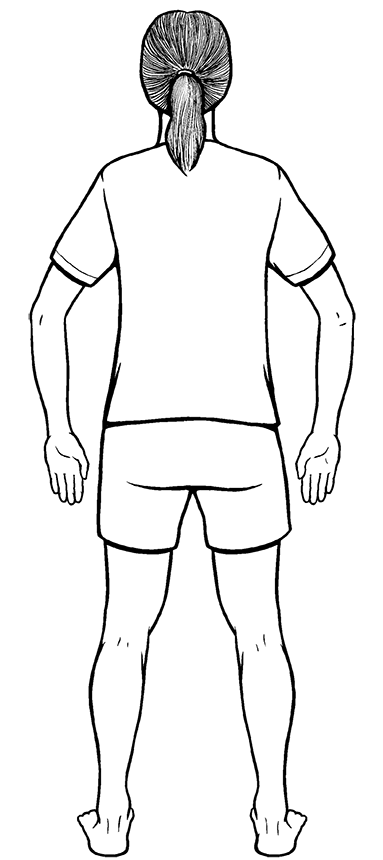Chinese Healing Exercises (32 page)
Read Chinese Healing Exercises Online
Authors: Steven Cardoza
Tags: #Taiji, #Qi Gong, #Daoist yoga, #Chinese Healing, #Health, #medicine, #remedy, #energy

Neither the numbers nor the words “inhale, exhale” have any particular
meaning
to
deepen your meditation. They are not religious or spiritual mantras. They are devices to
teach your mind to focus on one thing, or at most two, as some of your attention will be on your proper breath. Anything that narrows the focus of your mind frees it from being distracted by the part of your mind that generates random thoughts. With practice, you'll come to recognize the distracting parts of your mind even while not meditating, and will become better at quieting them, like a parent calming a crying child. That will allow your mind to sink into deeper parts of itself undisturbed, and along the way to learning more about yourself and your true nature, you'll enjoy better health by lowering your stress levels and maintaining mental and emotional calm.
At first, don't tax yourself by trying to meditate too long. If you've never meditated, ten minutes is a good length of time to begin with. Don't get frustrated when your attention wanders or you lose your count. That will happen, and it happens with everyone. It happens less often the more your practice. You may soon find that ten minutes seems too restrictive, and that's when you should extend your meditation for longer periods. Once you get familiar with and acquire a taste for meditation, a half hour or more will pass very quickly.
6. Standing Practice
Standing practices have been the cornerstone of qi cultivation in many systems of qigong and gongfu (power-building practices used most typically for martial arts purposes, and in some advanced spiritual trainings) for thousands of years. I almost did not include standing in this book, since this practice is best learned as a complete qigong under the guidance of an experienced teacher. Recently, however, the virtues of standing as opposed to sitting, and of standing barefoot on the ground, have caught the attention of Western medical science, and researchers have found an interesting and revealing variety of health benefits from common everyday standing. So it seems like an introduction to this practice is in order, to give you a different perspective on a practice you might encounter in popular media elsewhere. After taking a look at some Western findings, you'll be given instruction in a basic standing practice commonly used as a preparation for Standing qigong. The practice requires a mindfulness and a specific full-body awareness beyond what the Western researchers studied, and so provides greater health benefits than those of ordinary standing.
Western medical science has determined that people who sit for more than four hours a day have an increased risk of death from natural causes, arising from an increase in obesity and metabolic syndrome (a complex of conditions including high blood pressure, high blood sugar, high cholesterol, and excess body fat around the waist, usually accompanied by fatigue), and includes cardiovascular disease and cancer. That risk increases the more hours per day that a person typically sits. This corroborates the ancient Chinese medical
observation that excess sitting damages the Spleen and Stomach, organs associated with
absorption and metabolism of nutrients, energy production, proper muscle functionality and strength, and along with other organs is involved in blood production. A poorly functioning Spleen will create Damp in the body, a pathogenic influence frequently involved with various tumor formations and many types of cancer, along with numerous other less serious conditions. Considering that, even common unstructured standing a few times throughout the day is a simple and useful strategy to improve health and longevity.
Evolving Western biosciences have begun examining “earthing” or grounding, the practice of standing preferably barefoot on the ground. These explorations have provided numerous scientific findings related to that simple practice, and many healthful physiologic changes have been demonstrated.
From a Western perspective, energy is usually associated with measurable quantities, such as electrons and ions. Because the skin is a very good electrical conductor, electrons and ions are relatively freely able to pass through it. Remember that the earth is a giant magnet, with a north and south pole, and it generates a lot of free electrons. When walking or standing barefoot on the ground, those electrons are transferred into your body through the soles of your feet. Kidney 1, the acupuncture point called the Bubbling Well point located at the ball of the foot and introduced earlier in this book, is known to be an especially strong conductor of earth energy, and is responsible for all the rising currents of qi within the body.
Free electrons provide many benefits. Foremost, they are very powerful antioxidants and are capable of producing healthful changes in heart rate and reducing inflammation. Decreasing inflammation most obviously reduces inflammatory pain, but inflammation also plays a role in almost every debilitating degenerative disease, including diabetes, heart disease, and cancer. Another factor in heart health, grounding rapidly increases zeta potential, a type of charge around red blood cells that causes the blood to thin, improving circulation and lowering blood pressure. It also reduces the red blood cells' tendency to clump together, so clots are less likely to form and existing clots may be broken down.
The antioxidant properties of free electrons make them able to quench, or neutralize, excess free radicals. This increases longevity, since free radicals can accelerate aging by causing genetic damage and mutation, damage the energy-producing mitochondria found in every cell, and reduce the efficiency of enzymes, which themselves are both antioxidants and regulators of virtually every biochemical process in the body. This includes the biochemical reactions necessary for all types of healing. Enzyme therapies are sometimes used by practitioners of naturopathic and orthomolecular medicine for that purpose.
Plastic or rubber-soled shoes act as insulators and cut off the flow of free electrons into the feet. This may cause, or at least contribute to, the many diseases of modern life. Free electrons are not the totality of healthy qi, but these findings support what qigong masters have said for millennia: “A wise man breathes through his feet.”
You can take advantage of these findings by simply standing more throughout the day, walking barefoot on the earth as much as possible, and if necessary changing your footwear to natural materials that more readily transfer electrons. If you want to maximize those benefits, and add many more beyond the basics of earthing, the following Standing practice will be very rewarding.
 Figure 11.5A (Standing Practice)
Figure 11.5A (Standing Practice)


Figures 11.5B and 11.5C (Standing Practice)
Method
This most basic Standing posture (Zhan Zhuang, “Standing Like a Stake” or “Pole Standing”) is a foundational practice found in most schools of qigong with minor variations, used in the early stages of qi cultivation as preparation for complete Standing qigong practices. Here the body is regulated even when standing still, when there is very little going on externally that is observable to an untrained eye. It is sometimes referred to as Standing Meditation, but most practitioners simply refer to this as “Standing Practice” or just “Standing” (
Fig 11.5A
â
Fig 11.5C
on previous pages).
Here are the basic alignments and regulations. Keep in mind, for any one alignment to be fully accomplished, all must eventually be adhered to simultaneously. This may take some time, even in this early stage of practice. We'll begin at the feet, the body's foundation, and work our way up from there.
- Standing upright, place your feet parallel, at shoulder width apart.
- The weight of the entire body should be spread evenly across the sole of each foot, with no emphasis placed toward either the ball of the foot or the heel. Do not let your ankles collapse inward or outward.
- Bend your knees slightly, keeping them relatively straight but not locked. Even with the knees slightly bent, try to maintain a sense of lift at the back of your knees, so that the whole joint space feels open.
- The knees should bear no weight at all, but rather transfer the weight of the upper body to and through the feet.
- The perineum is kept open, most simply by making sure your knees are not collapsed inward toward a knock-kneed position.
- Point your sacrum straight down to the ground, causing the curvature of the low back to become more flattened. Do this by relaxation and release of any tension in your low back, and not by tightening or tensing the belly.
- Create a slight bend or fold at the inguinal groove. When coupled with the sacrum pointing toward the ground, this has been likened to the sensation
of being just about to sit on a stool. That sensation may help give you the correct feeling for this part of the posture, but it can cause a tendency to stick the rear out some. Care must be taken to avoid that, as it will increase the curve in the low back, counter to the above instruction. - Raise your midriff, by increasing the distance between the iliac crest at the sides of the pelvis and the lowest ribs. This will help you to additionally flatten your lower back.
- Spread your shoulder blades comfortably away from the spine so that the palms of each hand can easily face rearward, with your thumbs lightly touching the sides of your upper thighs. In a common variation, palms face the sides of the thighs, but the shoulder blades are still spread from the spine.
- Your head should lift toward the ceiling with a sense of being drawn upward either magnetically or as if lightly pulled by a string, helping to reduce the curvature of the mid and upper spine while creating a sense of openness and separation between the top vertebra and the base of the skull. So, the lower spine should feel like it's dropping as if to sit, while the mid and upper spine have a sense of rising.
- Keep your jaw parallel to the ground while tucking your chin, drawing it rearward to further lessen the curve of the neck while increasing the gap between the occiput and atlas (first cervical vertebra).
- Place the tip of the tongue on the roof of your mouth, on the hard palate directly behind your upper teeth.
- As much as the mid and upper spine are rising, your chest should feel a commensurate dropping or sinking, without a sense of collapse. The sinking of the chest combined with the spread of the shoulder blades should produce a sense of a hollow or depression forming just toward the midline of the body from the front of the shoulders, as well as an openness in the armpits.
- Keep your belly soft, and your whole body relaxed.
Every aspect of this posture creates openness while in stillness, reducing any physical obstruction to qi flow, so that whatever amount of qi you have available to you at any time will be able to move through you as freely as possible. If you stand barefoot on the
ground, all the earthing benefits will be increased. Celestial energies are descending at the
same time, and this posture will allow you to access those as well. At this stage of practice, you don't need to think about the earth or celestial energies. Keeping your mind as still as possible will do you the most good.